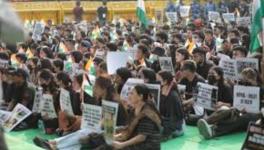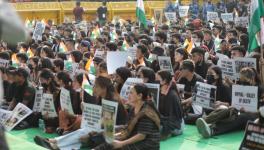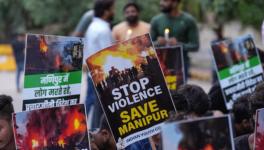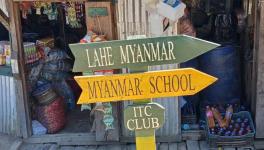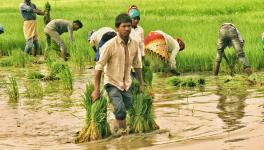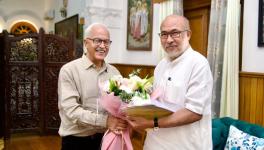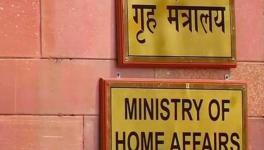Woman who Broke Story of Rapes During Manipur Conflict Speaks out
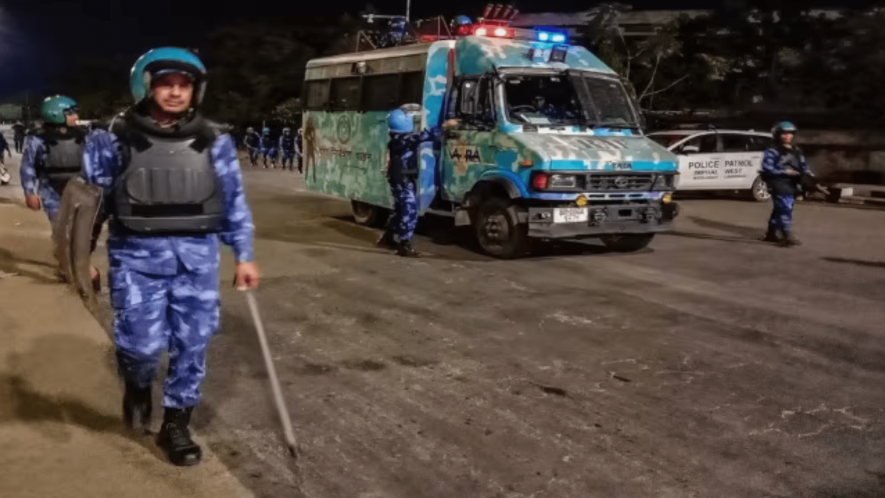
Rapid Action Force personnel conduct a flag march amid ongoing violence in Manipur, in Imphal, Sunday night, May 7, 2023. Image Courtesy: PTI
Hoineilhing Sitlhou, an assistant professor at the School of Social Sciences, University of Hyderabad, first brought to light the rapes of Kuki women during the ongoing conflict in Manipur in an article published in NewsClick on June 2. In this email interview with Pragya Singh, she describes how she learned about the incidents, confirmed them, and what she thinks of the disturbing video of one of those incidents going viral. Edited excerpts:
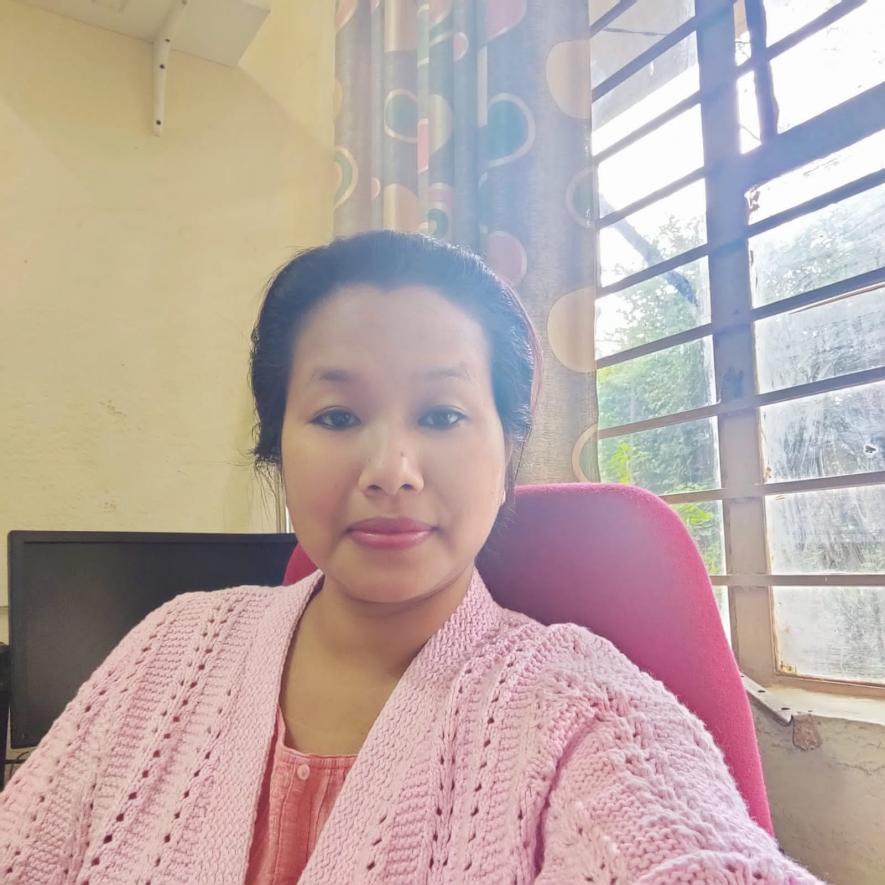
Pragya Singh: Now that many in the media have taken note of and reported on the sexual violence against Kuki women, do you feel vindicated that your efforts to bring to light these incidents were not wasted?
Hoineilhing Sitlhou: Yes, I do feel my efforts have not been wasted. Though it is still a long road before justice is given to them, acknowledging the atrocity being committed on the victims by both state officials and the public is an important step. I hope now that all the stakeholders involved, including media support, will persevere until the end.
PS: How did you first hear about these episodes of rape during the conflict in Manipur?
HS: The news of the death of the two girls who worked in a car wash in Imphal had gone viral, though nobody had confirmed the information. I think the girls’ parents took time to decide what to do. They had heard the horrific news of what had been done to their daughters from their co-workers, so you can imagine how distraught they must have been. But the surreal aspect is that they could not even go to the Valley to see the corpses of their daughters.
As for the naked parading and sexual assault case, of which we have now seen a video, I got to know about it from a documentary made by the Zomi Students’ Federation. Everyone in the Kuki-Zo community is deeply affected and emotionally charged by what is happening in Manipur, so the news about the turmoil quickly went viral.
I did find it strange that these two incidents, though similar in terms of the atrocities against women, had happened in different parts of the state—Imphal and a village in the Kangpokpi district—but on very close dates, May 5 and 4.
PS: Why did you decide to write about these incidents, and how did you confirm them?
HS: There was a lot of disinformation floating around, like the instances I mentioned in my article about Meitei women being raped by Kuki men during the first days of the conflict. Though concerned citizens often corrected these fake news items, their debunking never had as much impact as the fake news itself. For example, on a WhatsApp group located outside Manipur, a professor from a reputed university in another northeastern state kept asking about “the five Meitei women raped in Kangvai [a village in the Churachandpur district]”.
While the WhatsApp group members were located outside Manipur, where there was a strict internet ban, telephones and SMS services were operational. People coming from outside Manipur, or returning to the state, were using SMS and phones heavily, which contributed to spreading the fake news. However, the photos circulated were of incidents that had no connection with Manipur but showed to be as such.
I realised that many people would easily believe such disinformation. These were not innocent rumours passed around by people unaware of the consequences—it was intended to misguide the masses. Some of the accounts of the survivors have proved that these rumours and misinformation campaigns were used to justify the atrocities against them as “acts of retribution”.
All the fake news and news countering them were already floating around—I just had to weave them together in a story. For this, I also credit the media cell of the Indigenous Tribal Leaders’ Forum (ITLF), which has been painstakingly documenting every aspect of the ongoing ethnic pogrom.
Initially, I thought these were two different instances of unrelated violence. It wasn’t until I heard the survivors’ narratives that I realised there was a connection between the fake news and the actual atrocities perpetrated on Kuki-Zo women.
PS: Apart from the connection you establish between fake news providing the excuse for retribution against Kuki women, you also highlight that people were susceptible to this fake news—it seemed to allow them to enact their hatred. What is the way out so that such incidents don’t recur?
HS: Manipur is a small state in terms of geography and population. Therefore, it is not impossible to cross-check rumours, theories and conjectures—if only one tries! That is why I believe that people who thought the fake news was accurate must have a reason to believe it.
The geographical separation between the Kukis and the Meiteis that is happening now, except in a few pockets, is good in terms of ensuring the safety of women. Therefore, a separate administration would be the most effective approach to ensure the long-term safety of women. Most of the atrocities on women had happened at the beginning of the ethnic strife. But I cannot say that atrocities are no longer taking place. There can be unreported cases and those not registered by the police.
PS: What happened to Kuki women was akin to a battle being enacted on their bodies. Could the state and Central governments have responded differently to safeguard Kuki women?
HS: Many survivors of the violence in Manipur have spoken out about the indifference of the state police and commandos to their plight in different situations, either when their houses were being burned or when they ran to police stations for help, etc. The state has taken an interest in the issue after the video of the women being paraded went viral because top politicians ordered attention to the incident. Five men in the video had been arrested as of Sunday, July 23.
The victim’s families are now apprehensive because they find it difficult to trust an investigation by the same police that was indifferent to them or on the side of the perpetrators. That same police will be recording their statements as per the Criminal Procedure Code and so on.
It will be better to have a Special Investigation Team monitored by the Supreme Court or a fact-finding team monitored by National Commission for Women. At the end of the day, it is important that justice is defined not only from the point of view of the state but also from the point of view of the families of the victims.
PS: What was your own reaction to the video being leaked? Was it the only way to bring attention to such brutalities?
HS: The whole Kuki-Zo community has been in mourning since the video went viral. The thought of the public humiliation of our sisters being watched by millions across the country is sickening. We felt angry at how our sisters, the victims, were dishonoured, groped and molested in full public view. We did find succour in the fact that many people all over the world joined us in our grief and in condemning the political system that emboldens the perpetrators. It was a testimony to the fact that some level of humanity is left in the world, even if it has shrunk to the point of non-existence in Manipur. I felt it was unfair to the women in question. They had suffered enough, and now they would be forced to go through the ordeal all over again.
But, sadly, I must say the video was very effective in awakening the nation to the plight of these women.
PS: Did the media take up the issues concerning women in the conflict in Manipur as you would have hoped or wanted? Is the media in Delhi more proactive in reporting on the rapes you brought to light than the media in Manipur?
HS: As a woman, it was distressing to listen, hear or read (and now see) the stories of atrocities. When I spoke to the parents of the victims in the car wash at Konung Mamang, Imphal, they were very hopeful that I could do something about the injustice done to their daughters. But it is a fact that I did not have any power of that sort except to bring their story out in the world. I could feel their powerlessness, helplessness and their pain—it is a story that all oppressed minorities anywhere will understand. I am glad NewsClick trusted me and my account.
Most media houses in Manipur are very biased and one-sided. There have also been stories of how journalists who travelled to Manipur were threatened by mobs which do not want objective reportage—like Afrida Hussain of the India Today Group. The media houses in Delhi have been more proactive in bringing out the narratives on both sides of the divide, which is very commendable.
PS: Is there Meitei dominance over the media within Manipur, and did it have a role in how easily the violence against women was almost completely ignored?
HS: Yes, there is no doubt about that. In my case, I chose not to give my story to the local dailies—I thought they would not publish it. Even if they did, it might unnecessarily endanger the victims, as the perpetrators might be on the lookout with the intent to silence them.
PS: Had there not been an internet ban, would the national media, the political dispensation in Delhi, and the Indian public have responded differently, or at least sooner, to these atrocities?
HS: I am not sure about this.
PS: Can you tell us about the women you wrote about in the story published in NewsClick on June 1? How did they or their friends and families respond to the video leak?
HS: Manipur is a conflict-prone state, and we are used to situations of strife and disorder. But the victims’ families would not have imagined that it would escalate to this level, last this long, or that the unfortunate incidents could happen to their own families.
PS: What does the sheer cruelty of the incidents of the May 3, 4, and 5, and after that mean to Kuki women? Do they feel powerless?
HS: It seems to me that the victims did not expect such a level of inhuman acts from their fellow human beings. But let’s also be clear about the political question; the women were targeted not because they are women but because they are Kuki-Zo women.
PS: We don’t know yet who “leaked” this video or why. Could it be someone who felt remorse after the attack on the women? Is it a part of politics? Was it done to end the pause in the violence in Manipur or to escalate the conflict? What would be your educated guess?
HS: This is the same question that everyone has been asking. We only have speculations and conjectures. Could it be intentional to provoke or escalate the conflict? Why was the heinous crime video-recorded in the first place? Did the ban on the internet stop them from releasing it earlier? Could the release of the video have been done with the intention to challenge the Kuki-Zo men and remind them of their incompetence in protecting women? Or was it done because they had believed the fake news campaigns about attacks against Meitei women and wanted to demonstrate they are capable of revenge? If it was leaked by those on the side of the victims—as those standing by the perpetrators allege—the question then arises, how did they get hold of such a sensitive video?
PS: Do you think the full extent of the violence against women has come to light?
HS: There are other cases of atrocities on women, which might not be necessarily sexual in nature. For example, on June 9, the aged lady, Mrs Domkhohoi (75 years old) from Khoken village, was killed while praying. She was then branded as a sniper of the Kuki militants. On July 6, the schizophrenia patient, Mrs Donngaihching, 62 years old, was also shot dead in broad daylight and branded a suicide bomber.
I feel it is a grave injustice and violation of the human rights of the deceased that they were defamed. It goes against Article 21 of the Constitution, which mandates the right to life, and fair treatment and dignity, not only for living persons but also for the dead. Moreover, according to Section 499 of the Indian Penal Code 1860, a deceased person cannot be defamed by any statement made or published intending to harm their reputation. To restore their ‘social image’, these innocent victims must get decent obituaries.
Get the latest reports & analysis with people's perspective on Protests, movements & deep analytical videos, discussions of the current affairs in your Telegram app. Subscribe to NewsClick's Telegram channel & get Real-Time updates on stories, as they get published on our website.









